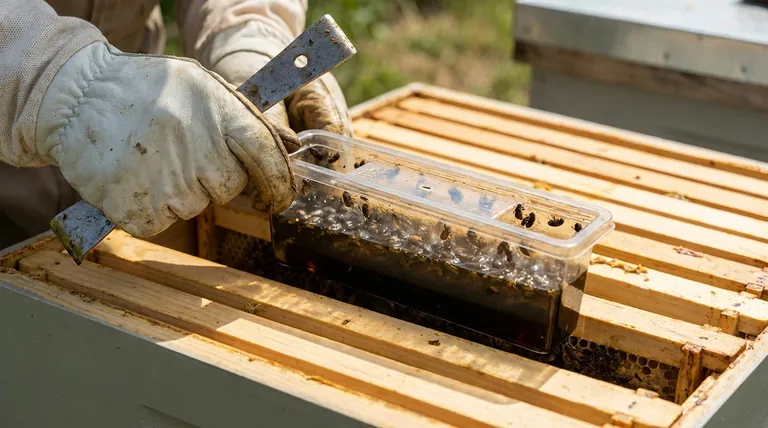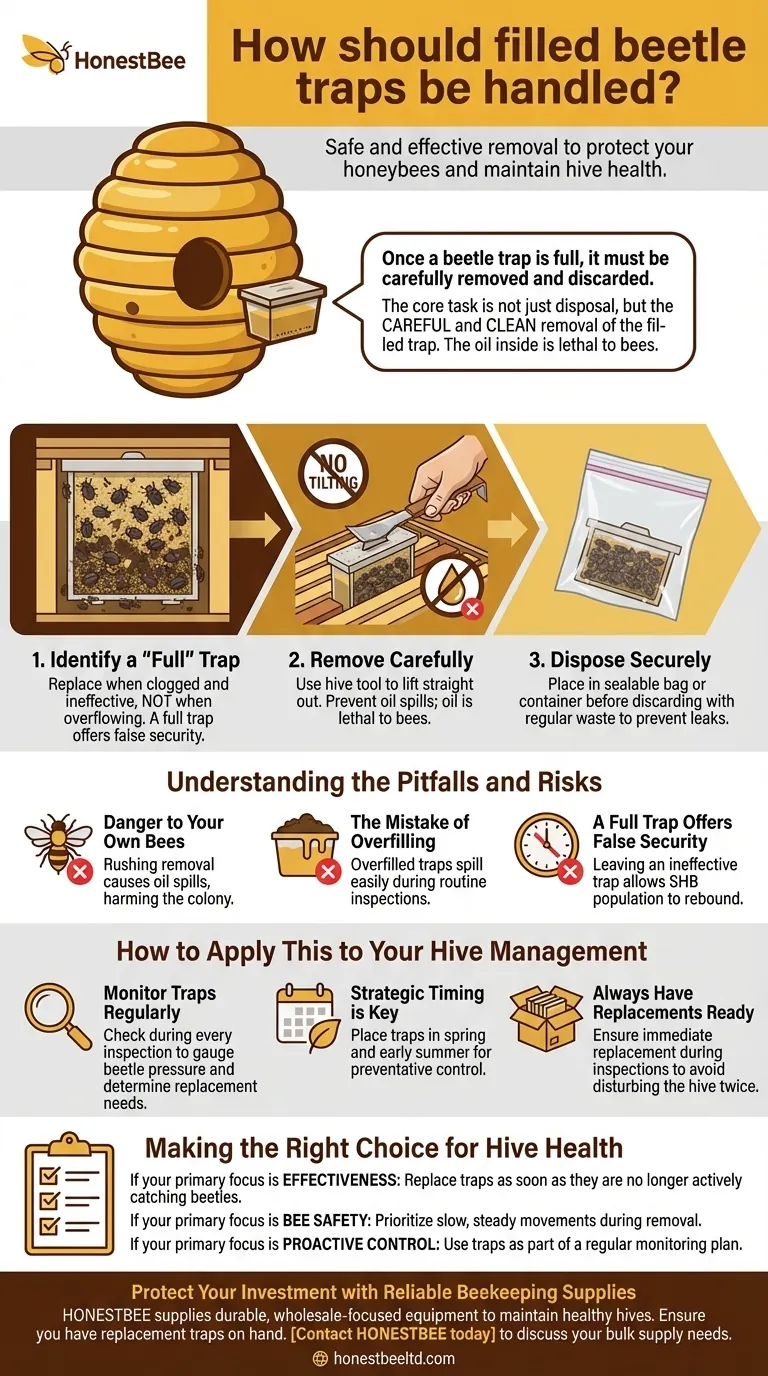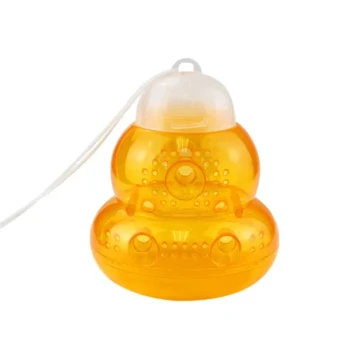Once a beetle trap is full, it must be carefully removed and discarded. These traps are designed to be disposable, and their safe handling is critical to ensure you are protecting your honeybees, not harming them.
The core task is not just disposal, but the careful and clean removal of the filled trap. The oil inside is lethal to bees, so preventing spills within the hive is the most important part of the process.

The Correct Procedure for Handling Filled Traps
A filled trap is no longer protecting your colony. Following a precise removal process ensures you maintain control over small hive beetles (SHB) without introducing new risks to your bees.
Identifying a "Full" Trap
A trap is considered "full" and ineffective long before it is overflowing. It needs replacement when it is clogged with dead beetles and debris to the point that new beetles can no longer be caught.
The Removal Process
Use your hive tool to gently and slowly pry the trap up. The goal is to lift it straight out without tilting it, which could cause the oil and its contents to spill onto the frames or into the hive body.
The Primary Risk: Oil Spills
The mineral or vegetable oil used in these traps is indiscriminate. While it effectively drowns beetles, it will also kill any honeybees that come into contact with it. A single spill can be a significant setback for the colony.
Secure and Final Disposal
Once removed from the hive, place the filled trap into a sealable plastic bag or container. This prevents any remaining oil from leaking into your apiary or the environment. It should then be thrown away with your regular waste.
Understanding the Pitfalls and Risks
Simply using traps is not enough; using them correctly means understanding the potential downsides and how to mitigate them.
Danger to Your Own Bees
The most immediate risk is harming the colony you are trying to protect. Rushing the removal process is the most common cause of oil spills. Always work deliberately when handling traps inside the hive.
The Mistake of Overfilling
When first setting a trap, avoid the temptation to overfill it with oil. An overfilled trap is much more likely to spill during routine hive inspections, even if you aren't planning to remove it yet.
A Full Trap Offers False Security
Leaving a filled, ineffective trap in the hive is a critical error. It occupies space without doing its job, allowing the SHB population to rebound while you believe the hive is still protected.
How to Apply This to Your Hive Management
Properly handling filled traps is a small but essential part of a larger Integrated Pest Management (IPM) strategy for small hive beetles.
Monitor Traps Regularly
Checking your traps should be a standard part of every hive inspection. This allows you to gauge the level of beetle pressure and know exactly when a trap needs to be replaced.
Strategic Timing is Key
As a preventative measure, traps are most effective when placed in the spring and early summer. This helps control the SHB population before it can explode and cause significant damage to the colony.
Always Have Replacements Ready
Since these traps are disposable, always have new, clean traps on hand. This ensures you can immediately replace a full one during an inspection without having to disturb the hive a second time.
Making the Right Choice for Hive Health
- If your primary focus is effectiveness: Replace traps as soon as they are no longer actively catching beetles, not when they are overflowing.
- If your primary focus is bee safety: Prioritize slow, steady movements when removing a filled trap to eliminate the risk of an oil spill.
- If your primary focus is proactive control: Use traps as part of a regular monitoring plan, especially in the spring, to keep beetle populations in check from the start.
Treating trap replacement as a careful and essential task is a hallmark of a diligent beekeeper.
Summary Table:
| Step | Key Action | Why It's Critical |
|---|---|---|
| 1. Identify Full Trap | Replace when clogged with beetles/debris, not overflowing. | An ineffective trap offers false security. |
| 2. Remove Carefully | Use a hive tool to lift the trap straight out, without tilting. | Prevents lethal oil from spilling onto bees and frames. |
| 3. Dispose Securely | Place the trap in a sealable bag before discarding with regular waste. | Contains oil and prevents environmental contamination. |
Protect Your Investment with Reliable Beekeeping Supplies
As a commercial apiary or beekeeping equipment distributor, your success depends on effective pest management. HONESTBEE supplies the durable, wholesale-focused equipment you need to maintain healthy, productive hives. Ensure you always have replacement beetle traps on hand to act quickly during inspections.
Contact HONESTBEE today to discuss your bulk supply needs and keep your operation running smoothly.
Visual Guide

Related Products
- Removable Washable Hive Beetle Trap Attractants for Small Hive Beetles
- Reusable Aluminium Beetle Trap for Small Hive Beetles Silver Bullet
- Black Plastic Beetle Barn Hive Beetle Trap for Beehives
- Reusable Clear Small Hive Beetle Traps for Beehives Beetle Trapping Tools
- Plastic Beetle Blaster Trap Beekeeping Tools and Supplies
People Also Ask
- What are small hive beetles and where are they not indigenous? Protect Your Apiary from This Invasive Pest
- How do Beetle Blasters trap adult beetles? A Simple, Non-Chemical Pest Control Solution
- What should be done if a hive shows signs of a small hive beetle infestation? Protect Your Hive Now
- How do hive beetle traps work? A Beekeeper's Guide to Non-Chemical Control
- What are the chemical-free options for trapping hive beetles? Control Pests Without Chemicals



















